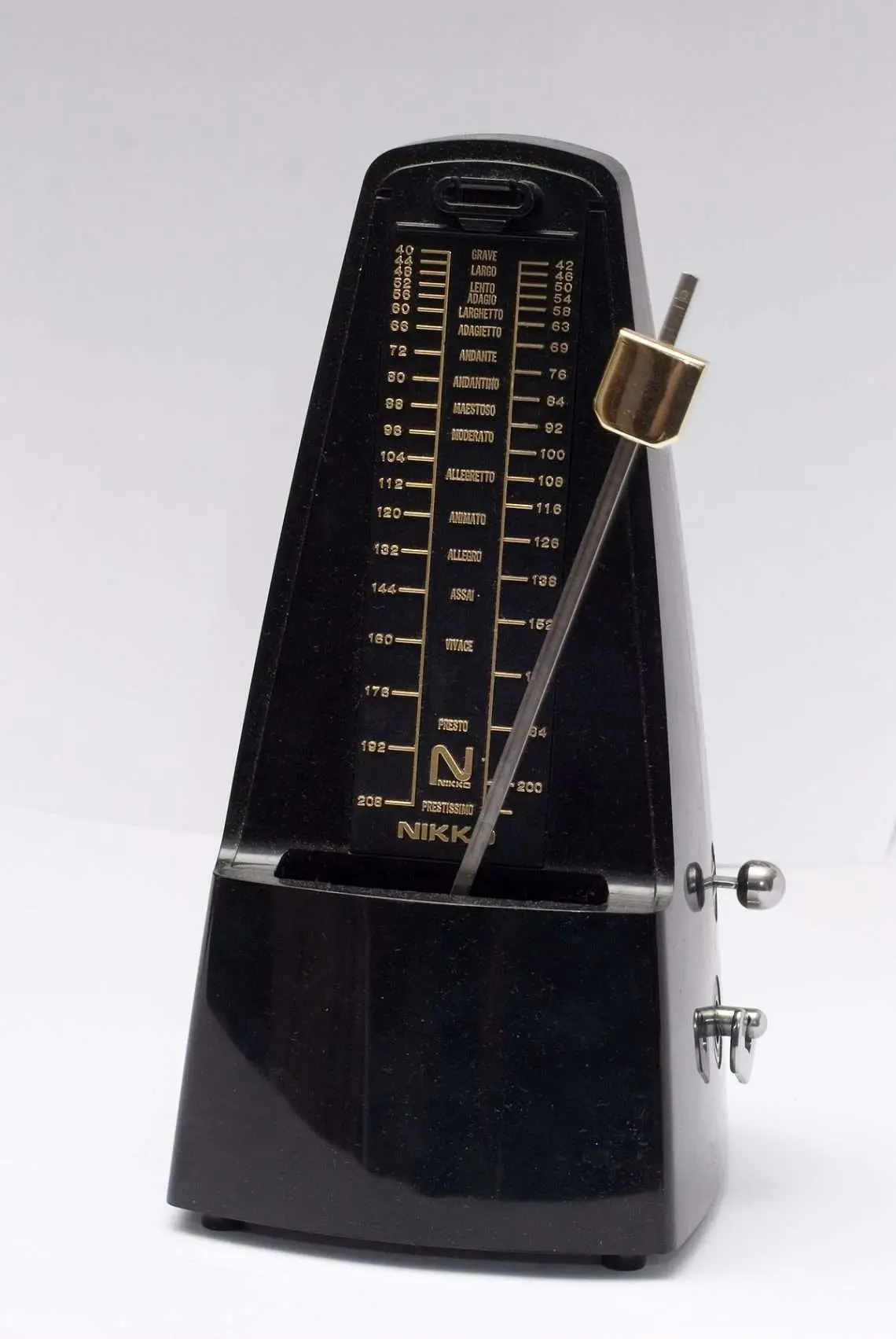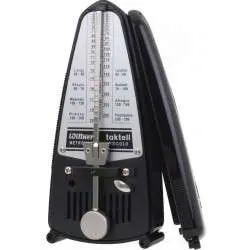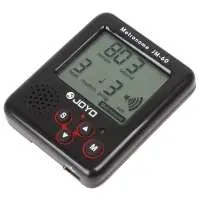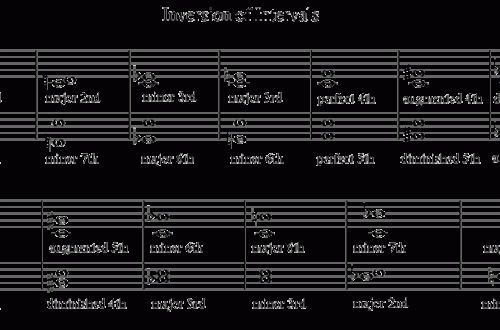
What is a metronome
Contents
It’s no secret that in music of any genre, the tempo is very important – the speed with which the work is performed. However, strictly observing the required tempo can be difficult not only for beginners, but also for professional musicians, because each person can make a mistake, slow down or speed up the tempo of playing the instrument excessively. This is where the metronome comes in.
This very useful device will be discussed in our article.
More about the metronome
So, a metronome (from the Greek metron – measure and nomos – law) is a device that marks short periods of time with uniform beats. It helps to navigate the musical tempo and follow it steadily. The device is also useful for people learning to play the piano – thanks to the metronome, the student masters the skill of smooth and rhythmic performance of music.
A classic mechanical metronome is a pyramidal wooden case with a cut edge, in which the beat frequency scale and a pendulum with a weight are located. Depending on the height at which the load is fixed, the frequency of impacts of the device changes. Today, electronic metronomes are gaining more and more popularity.

History of the metronome
 The metronome has been around for more than 200 years, but its mechanism is closely related to the invention made by Galileo Galilei around 1637 – he discovered the principle of the regular movement of the pendulum. This discovery led to the invention of the clock escapement and, in the future, the metronome.
The metronome has been around for more than 200 years, but its mechanism is closely related to the invention made by Galileo Galilei around 1637 – he discovered the principle of the regular movement of the pendulum. This discovery led to the invention of the clock escapement and, in the future, the metronome.
Many scientists and music masters worked on the creation of a device that sets the pace of music, but the first full-fledged metronome was created only in 1812 by the German musician and engineer Johann Melzel (1772-1838). This device (a hammer striking a wooden anvil and a measurement scale) was partly based on the earlier developments of the mechanic Dietrich Winkel. In 1816, this version of the metronome was patented and gradually became popular among musicians due to its usefulness and convenience. Interestingly, the first to use this device was the composer Ludwig van Beethoven. He also initiated the designation of the tempo and musical works in the number of beats per minute according to Mälzel’s metronome.
Serial production of metronomes began only in 1895 at the initiative of Gustave Wittner, an entrepreneur from Germany. The small company he founded, WITTNER, expanded over time and still produces TAKTELL high-precision mechanical metronomes, earning the title of one of the best manufacturers.
Types and types of metronomes
There are two types and types of metronomes – mechanical and electronic. Let’s talk in more detail about their features, pros and cons.
Mechanical
 Such a device can have not only the shape of a pyramid, but also any other – there are even models in the form of a decorative figure of an animal. The metronome device remains unchanged. It is actuated by a spring in the case, which is wound by a rotating handle on the side of the case. Based on the required speed of execution of a particular work, the weight on the pendulum is fixed at one or another height. To increase the pace , you need to move it higher, and to slow it down, lower it down. Typically, tempo settings range from a minimum “grave” frequency (40 beats per minute) to a maximum “pretissimo” (208 beats per minute).
Such a device can have not only the shape of a pyramid, but also any other – there are even models in the form of a decorative figure of an animal. The metronome device remains unchanged. It is actuated by a spring in the case, which is wound by a rotating handle on the side of the case. Based on the required speed of execution of a particular work, the weight on the pendulum is fixed at one or another height. To increase the pace , you need to move it higher, and to slow it down, lower it down. Typically, tempo settings range from a minimum “grave” frequency (40 beats per minute) to a maximum “pretissimo” (208 beats per minute).
The mechanical metronome has many advantages:
- the device is easy to use and does not require special skills;
- it is completely autonomous, does not need charging and batteries;
- you can easily choose a stylish metronome with an unusual design that will decorate your interior.
The disadvantages can be considered the lack of additional functions and settings, as well as a fairly massive case that does not fit in your pocket.
Electronic
 Electronic metronomes have many differences from mechanical ones. They are made of plastic in the shape of a small rectangle and are equipped with a display, buttons and a speaker. As a rule, their frequency range varies from 30 to 280 beats in 60 seconds. An additional advantage is a wide range of settings – changing the sound of the metronome beat, creating different rhythms, timer, tuner , etc. There is also a version of this device for drummers, equipped with additional connectors for connecting to equipment.
Electronic metronomes have many differences from mechanical ones. They are made of plastic in the shape of a small rectangle and are equipped with a display, buttons and a speaker. As a rule, their frequency range varies from 30 to 280 beats in 60 seconds. An additional advantage is a wide range of settings – changing the sound of the metronome beat, creating different rhythms, timer, tuner , etc. There is also a version of this device for drummers, equipped with additional connectors for connecting to equipment.
The advantages of this type of metronomes are as follows:
- compact dimensions and easy storage;
- advanced functionality;
- the ability to connect headphones and other devices.
Not without drawbacks:
- the device may seem difficult to use for beginners;
- lower reliability compared to the mechanical version.
In general, the choice between a mechanical and electronic metronome should be made based on your needs and the purpose of using the device .
Online metronomes
Check out the following free online metronomes:
Musicca
- visual instruction for beginner musicians;
- user-friendly interface;
- tempo setting from 30 to 244 beats per minute;
- the ability to select the desired number of beats per measure .
Metronomus
- ease of use;
- range 20-240 beats per minute;
- a wide selection of time signatures and rhythmic patterns.
These and other programs (for example, a metronome for a guitar or other instrument) can be found on the Internet and downloaded for free.
What our store offers
The store of musical instruments “Student” has a large assortment of high-quality metronomes, for example, these models:
Wittner 856261 TL, mechanical metronome
- case material: plastic;
- black color;
- built-in call.
Wittner 839021 Taktell Cat, mechanical metronome
- case material: plastic;
- pace : 40-200 beats per minute;
- original case in the form of a gray cat.
Cherub WSM-290 digital metronome
- built-in mechanical and electronic metronome sounds ;
- the ability to adjust the volume;
- body: classic (pyramid);
- Li-Pol battery.
Wittner 811M, mechanical metronome
- wooden case, matte surface;
- color: mahogany;
- built-in call.
Answers on questions
Which metronome is better to buy for a child studying at a music school?
The best option would be a moderately priced mechanical metronome. It is worth taking a closer look at light plastic models in the shape of animals – such a device will definitely please your child and make his learning more interesting.
Can an online metronome replace its classic version?
When a metronome is not at hand, a virtual version of it can really help. However, playing the piano and using a laptop or smartphone at the same time may not always be convenient, while setting up a mechanical metronome is much easier and faster.
Do I need to listen to the metronome before buying?
It is advisable to do this, because then you will understand whether you like the sound of the metronome or it is better to look for a model with a different “ timbre ”.
conclusions
Let’s summarize. A metronome is an indispensable instrument for musicians, regardless of their skill level. If you have recently become acquainted with the world of music, we can safely recommend any mechanical metronome that will suit you in terms of price, design and body materials.
For more experienced people, an electronic metronome with one or another set of functions, depending on the requirements for it, is suitable.
In any case, we wish you to find your perfect metronome, thanks to which the music will always sound at the same pace and mood as the composer originally intended.





